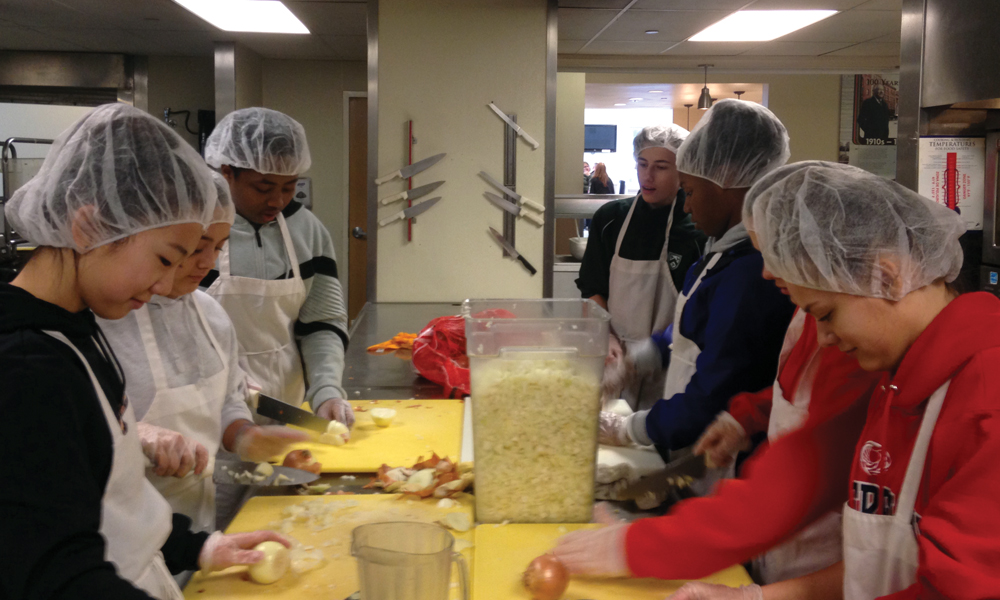Taking Care of People, Taking Care of Place
By Mark E. Hayes
Coordinator of Service Learning and Sustainability, Upper School English Teacher
Service without learning is good, but service with learning is the best we can do in a school setting.
The 18th century British writer John Evelyn, one of the earliest conservationists, wrote in his groundbreaking work on forestry, Silva, a key sentence that articulates how people can benefit from tending the land: “Gardening,” Evelyn writes, “is a labour full of tranquility and satisfaction; natural and instructive, and as such contributes to the most serious contemplation, experience, health, and longevity.”
In taking care of place, he suggests, the place naturally takes care of us. This loop of shared stewardship is very much in the spirit of the community of caring that is part of many ongoing conversations at Charles Wright—caring not just about plants but about all aspects of a place and all of its inhabitants. In this sense service and sustainability are closely linked, as we are, whether we recognize it or not, part of our environment and not separate from it.
Taking care remains at the heart of what we call service, whether we mean community service or service learning, although the two notions are not interchangeable. Community service is a broad term that can refer to charitable giving, donations of materials, volunteering, and a wide range of partnerships.
As CWA moves toward a more clearly defined framework of service learning, it is important to understand the ways in which that model works well in school settings to support and enhance the learning that goes on throughout the institution.
As the well-worn saying goes, “You give a poor man a fish, and you feed him for a day. You teach him to fish, and you give him an occupation that will feed him for a lifetime.” While fish donation covers the charity model, fishing instruction is a useful example of volunteerism—but neither of these helps to explain service learning.
In service learning (with a sustainability angle) we might say something like: “Having some more fish here seems like a good idea. Let’s both learn how to fish responsibly—what do we need to do that?” In this model, the environment benefits, the fish benefit, and the people work as partners in learning to solve a problem.
Education, after all, is about helping people develop into the full person they can be—and a liberal arts education, in particular, is intended to produce a well-rounded person who can think across disciplines and, faced with real-world challenges, can deploy that education in solving problems.
With the changes in service hours requirements in the Upper School—four hours that should be done off campus and four hours on campus—we hope to broaden and enrich the variety of service opportunities for all students. In addition to Chapel Home week, blood drives, the Christmas Connection dinner, and the many projects students take on around the region and during Winterim, we will have the opportunity to foster more creative and curriculum-driven service projects. In short, service can become a cohesive part of CWA’s everyday education.
The list of on- and off-campus service activities is long, and includes habitat restoration at Tinley Park, trail work along Peach Creek, preparing and serving food at Tacoma Rescue Mission, and walking all night to fight cancer with Relay for Life. And, with an eye on the priority of service learning, we hope that, in addition to caring for place and people, students were able to learn about ecosystems, ongoing cancer research, and the roots of and routes out of homelessness. Service without learning is good, but service with learning is the best we can do in a school setting.
A service-learning framework guided the development of a course to be offered in the 2018-2019 school year, Ecology of Food. Making use of the Upper School garden beds, students from the Eco Club have already planted a variety of herbs, vegetables, and (for pollinators) flowers, with the aspiration of having produce to harvest in the fall. While the growing plants fix carbon in the ground and bring some natural beauty to campus, students learn about soil science and horticulture.
At the start of the school year, the garden will provide ingredients for meals served in the Commons, as well as a living classroom for the Ecology of Food students, who will examine the industrial, organic, and local food production systems. In addition, students will learn the basics of flavor profiles and cooking and the social practices of preparing and serving meals. The class culminates with project-based assessment where students will design, prepare, and serve a meal of their own to the CWA community (and guests) in the Tarrier Bistro. It is literally learning and serving.
It is our hope that, eventually, all service with Charles Wright will be thoughtful, creative, and integrated into the lives of people we may know and the many places we may live. All service, not just gardening, should be work full of tranquility and satisfaction, natural and instructive, and contribute to meaningful experiences,
to well-rounded health, and to lifelong learning. //

